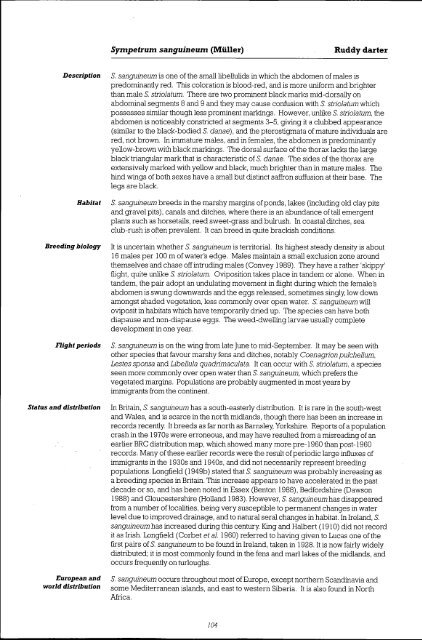Download - NERC Open Research Archive - Natural Environment ...
Download - NERC Open Research Archive - Natural Environment ...
Download - NERC Open Research Archive - Natural Environment ...
You also want an ePaper? Increase the reach of your titles
YUMPU automatically turns print PDFs into web optimized ePapers that Google loves.
Sympetrum sanguineum (Miller) Ruddy darter<br />
Description S. sanguiheum is one of the small libellulids in which the abdomen of males is<br />
predominantly red. This coloration is blood-red, and is more uniform and brighter<br />
than male S. stholatum. There are two prominent black marks mid-dorsally on<br />
abdominal segments 8 and 9 and they may cause confusion with S. striolatum which<br />
possesses similar though less prominent markings. However, unlike S. stholatum, the<br />
abdomen is noticeably constricted at segments 3-5, giving it a clubbed appearance<br />
(similar to the black-bodied S. danae), and the pterostigmata of mature individuals are<br />
red, not brown. In immature males, and in females, the abdomen is predominantly<br />
yellow-brown with black markings. The dorsal surface of the thorax lacks the large<br />
blacktriangular mark that is characteristic of S. danae. The sides of the thorax are<br />
extensively marked with yellow and black, much brighter than in mature males. The<br />
hind wings of both sexes have a small but distinct saffron suffusion at their base. The<br />
legs are black.<br />
Habitat S. sanguineurn breeds in the marshy margins of ponds, lakes (including old clay pits<br />
and gravel pits), canals and ditches, where there is an abundance of tall emergent<br />
plants such as horsetails, reed sweet-grass and bulrush. In coastal ditches, sea<br />
club-rush is often prevalent. It can breed in quite brackish conditions.<br />
Breeding biology It is uncertain whether S. sanguiheurn is territorial. Its highest steady density is about<br />
16 males per 100 m of water's edge. Males maintain a small exclusion zone around<br />
themselves and chase off intruding males (Convey 1989). They have a rather 'skippy'<br />
flight, quite unlike S. stholatum. Oviposition takes place in tandem or alone. When in<br />
tandem, the pair adopt an undulating movement in flight during which the female's<br />
abdomen is swung downwards and the eggs released, sometimes singly, low down<br />
amongst shaded vegetation, less commonly over open water. S. sanguine= will<br />
oviposit in habitats which have temporarily dried up. The species can have both<br />
diapause and non-diapause eggs. The weed-dwelling larvae usually complete<br />
development in one year.<br />
Flight periods S. sanguineum is on the wing from late June to mid-September. It may be seen with<br />
other species that favour marshy fens and ditches, notably Coenaghon pulchellum,<br />
Lestes sponsa and Libellula quadhmaculata. It can occur with S. stholaturn, a species<br />
seen more commonly over open water than S. sanguineum, which prefers the<br />
vegetated margins. Populations are probably augmented in most years by<br />
immigrants from the continent.<br />
Status and distribution<br />
European and<br />
world distribution<br />
In Britain, S. sanguine= has a south-easterly distribution. It is rare in the south-west<br />
and Wales, and is scarce in the north midlands, though there has been an increase in<br />
records recently It breeds as far north as Barnsley, Yorkshire. Reports of a population<br />
crash in the 1970s were erroneous, and may have resulted from a misreading of an<br />
earlier BRC distribution map, which showed many more pre-1960 than post-1960<br />
records. Many of these earlier records were the result of periodic large influxes of<br />
immigrants in the 1930s and 1940s, and did not necessarily represent breeding<br />
populations. Longlield (1949b) stated that S. sanguiheum was probably increasing as<br />
a breeding species in Britain. This increase appears to have accelerated in the past<br />
decade or so, and has been noted in Essex (Benton 1988), Bedfordshire (Dawson<br />
1988) and Gloucestershire (Holland 1983). However, S. sanguine= has disappeared<br />
from a number of localities, being very susceptible to permanent changes in water<br />
level due to improved drainage, and to natural seral changes in habitat. In Ireland, S.<br />
sanguine= has increased during this century King and Halbert (1910) did not record<br />
it as Irish. Longfield (Corbet et al. 1960) referred to having given to Lucas one of the<br />
first pairs of S. sanguine= to be found in Ireland, taken in 1928. It is now fairly widely<br />
distributed; it is most commonly found in the fens and marl lakes of the midlands, and<br />
occurs frequently on turloughs.<br />
S. sanguine= occurs throughout most of Europe, except northern Scandinavia and<br />
some Mediterranean islands, and east to western Siberia. It is also found in North<br />
Africa.<br />
104

















